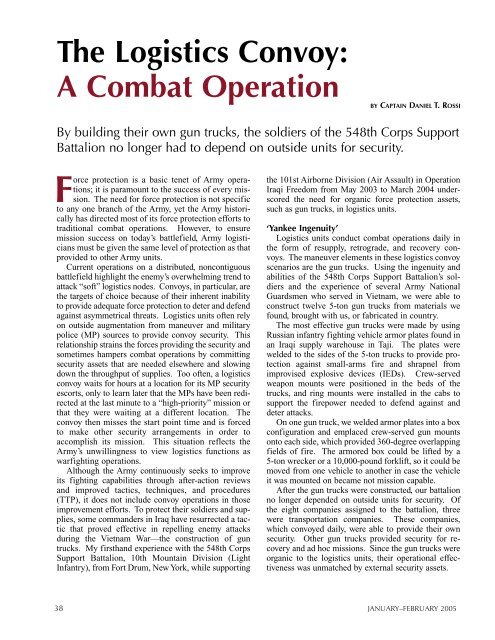Supporting the First Stryker Brigade in Iraq - Army Logistics ...
Supporting the First Stryker Brigade in Iraq - Army Logistics ...
Supporting the First Stryker Brigade in Iraq - Army Logistics ...
Create successful ePaper yourself
Turn your PDF publications into a flip-book with our unique Google optimized e-Paper software.
The <strong>Logistics</strong> Convoy:<br />
A Combat Operation BY<br />
Force protection is a basic tenet of <strong>Army</strong> operations;<br />
it is paramount to <strong>the</strong> success of every mission.<br />
The need for force protection is not specific<br />
to any one branch of <strong>the</strong> <strong>Army</strong>, yet <strong>the</strong> <strong>Army</strong> historically<br />
has directed most of its force protection efforts to<br />
traditional combat operations. However, to ensure<br />
mission success on today’s battlefield, <strong>Army</strong> logisticians<br />
must be given <strong>the</strong> same level of protection as that<br />
provided to o<strong>the</strong>r <strong>Army</strong> units.<br />
Current operations on a distributed, noncontiguous<br />
battlefield highlight <strong>the</strong> enemy’s overwhelm<strong>in</strong>g trend to<br />
attack “soft” logistics nodes. Convoys, <strong>in</strong> particular, are<br />
<strong>the</strong> targets of choice because of <strong>the</strong>ir <strong>in</strong>herent <strong>in</strong>ability<br />
to provide adequate force protection to deter and defend<br />
aga<strong>in</strong>st asymmetrical threats. <strong>Logistics</strong> units often rely<br />
on outside augmentation from maneuver and military<br />
police (MP) sources to provide convoy security. This<br />
relationship stra<strong>in</strong>s <strong>the</strong> forces provid<strong>in</strong>g <strong>the</strong> security and<br />
sometimes hampers combat operations by committ<strong>in</strong>g<br />
security assets that are needed elsewhere and slow<strong>in</strong>g<br />
down <strong>the</strong> throughput of supplies. Too often, a logistics<br />
convoy waits for hours at a location for its MP security<br />
escorts, only to learn later that <strong>the</strong> MPs have been redirected<br />
at <strong>the</strong> last m<strong>in</strong>ute to a “high-priority” mission or<br />
that <strong>the</strong>y were wait<strong>in</strong>g at a different location. The<br />
convoy <strong>the</strong>n misses <strong>the</strong> start po<strong>in</strong>t time and is forced<br />
to make o<strong>the</strong>r security arrangements <strong>in</strong> order to<br />
accomplish its mission. This situation reflects <strong>the</strong><br />
<strong>Army</strong>’s unwill<strong>in</strong>gness to view logistics functions as<br />
warfight<strong>in</strong>g operations.<br />
Although <strong>the</strong> <strong>Army</strong> cont<strong>in</strong>uously seeks to improve<br />
its fight<strong>in</strong>g capabilities through after-action reviews<br />
and improved tactics, techniques, and procedures<br />
(TTP), it does not <strong>in</strong>clude convoy operations <strong>in</strong> those<br />
improvement efforts. To protect <strong>the</strong>ir soldiers and supplies,<br />
some commanders <strong>in</strong> <strong>Iraq</strong> have resurrected a tactic<br />
that proved effective <strong>in</strong> repell<strong>in</strong>g enemy attacks<br />
dur<strong>in</strong>g <strong>the</strong> Vietnam War—<strong>the</strong> construction of gun<br />
trucks. My firsthand experience with <strong>the</strong> 548th Corps<br />
Support Battalion, 10th Mounta<strong>in</strong> Division (Light<br />
Infantry), from Fort Drum, New York, while support<strong>in</strong>g<br />
38<br />
CAPTAIN DANIEL T. ROSSI<br />
By build<strong>in</strong>g <strong>the</strong>ir own gun trucks, <strong>the</strong> soldiers of <strong>the</strong> 548th Corps Support<br />
Battalion no longer had to depend on outside units for security.<br />
<strong>the</strong> 101st Airborne Division (Air Assault) <strong>in</strong> Operation<br />
<strong>Iraq</strong>i Freedom from May 2003 to March 2004 underscored<br />
<strong>the</strong> need for organic force protection assets,<br />
such as gun trucks, <strong>in</strong> logistics units.<br />
‘Yankee Ingenuity’<br />
<strong>Logistics</strong> units conduct combat operations daily <strong>in</strong><br />
<strong>the</strong> form of resupply, retrograde, and recovery convoys.<br />
The maneuver elements <strong>in</strong> <strong>the</strong>se logistics convoy<br />
scenarios are <strong>the</strong> gun trucks. Us<strong>in</strong>g <strong>the</strong> <strong>in</strong>genuity and<br />
abilities of <strong>the</strong> 548th Corps Support Battalion’s soldiers<br />
and <strong>the</strong> experience of several <strong>Army</strong> National<br />
Guardsmen who served <strong>in</strong> Vietnam, we were able to<br />
construct twelve 5-ton gun trucks from materials we<br />
found, brought with us, or fabricated <strong>in</strong> country.<br />
The most effective gun trucks were made by us<strong>in</strong>g<br />
Russian <strong>in</strong>fantry fight<strong>in</strong>g vehicle armor plates found <strong>in</strong><br />
an <strong>Iraq</strong>i supply warehouse <strong>in</strong> Taji. The plates were<br />
welded to <strong>the</strong> sides of <strong>the</strong> 5-ton trucks to provide protection<br />
aga<strong>in</strong>st small-arms fire and shrapnel from<br />
improvised explosive devices (IEDs). Crew-served<br />
weapon mounts were positioned <strong>in</strong> <strong>the</strong> beds of <strong>the</strong><br />
trucks, and r<strong>in</strong>g mounts were <strong>in</strong>stalled <strong>in</strong> <strong>the</strong> cabs to<br />
support <strong>the</strong> firepower needed to defend aga<strong>in</strong>st and<br />
deter attacks.<br />
On one gun truck, we welded armor plates <strong>in</strong>to a box<br />
configuration and emplaced crew-served gun mounts<br />
onto each side, which provided 360-degree overlapp<strong>in</strong>g<br />
fields of fire. The armored box could be lifted by a<br />
5-ton wrecker or a 10,000-pound forklift, so it could be<br />
moved from one vehicle to ano<strong>the</strong>r <strong>in</strong> case <strong>the</strong> vehicle<br />
it was mounted on became not mission capable.<br />
After <strong>the</strong> gun trucks were constructed, our battalion<br />
no longer depended on outside units for security. Of<br />
<strong>the</strong> eight companies assigned to <strong>the</strong> battalion, three<br />
were transportation companies. These companies,<br />
which convoyed daily, were able to provide <strong>the</strong>ir own<br />
security. O<strong>the</strong>r gun trucks provided security for recovery<br />
and ad hoc missions. S<strong>in</strong>ce <strong>the</strong> gun trucks were<br />
organic to <strong>the</strong> logistics units, <strong>the</strong>ir operational effectiveness<br />
was unmatched by external security assets.<br />
JANUARY–FEBRUARY 2005







